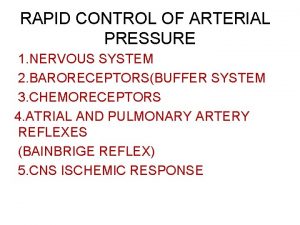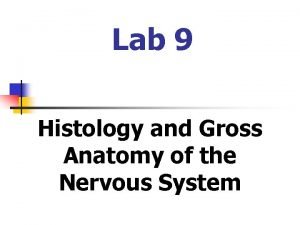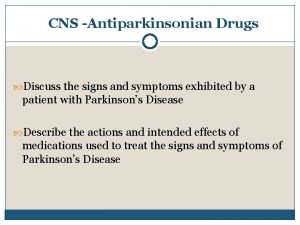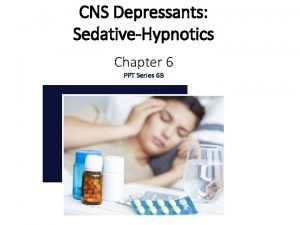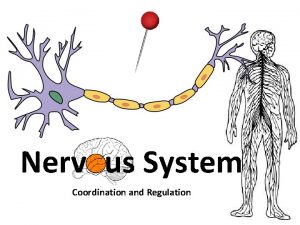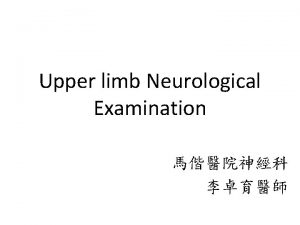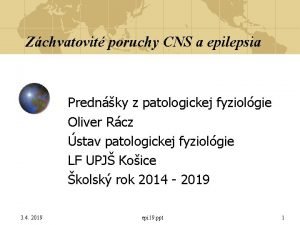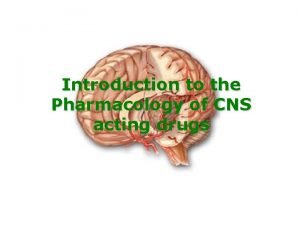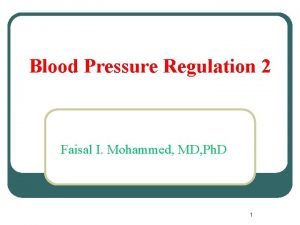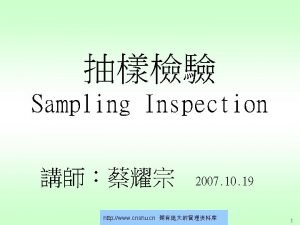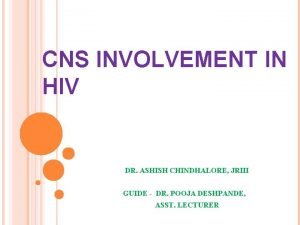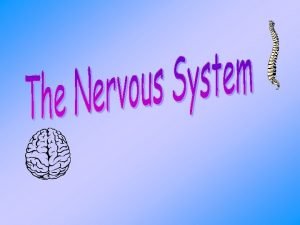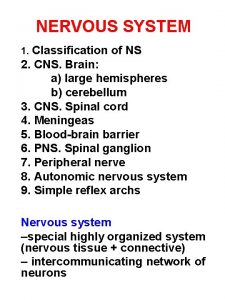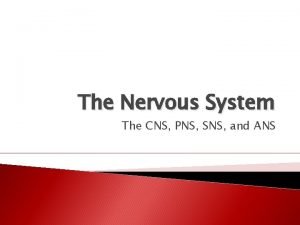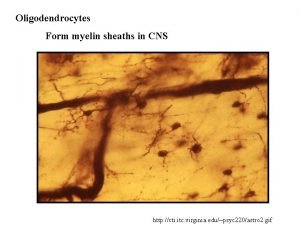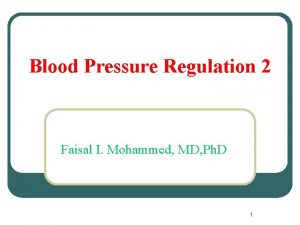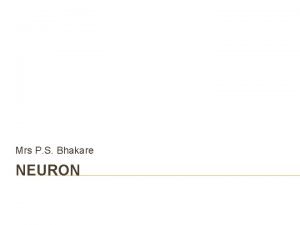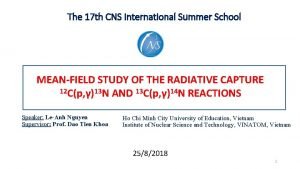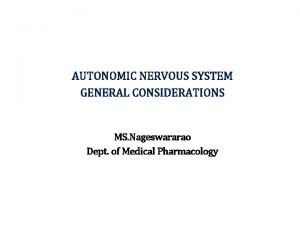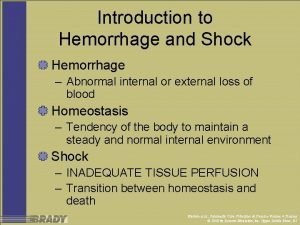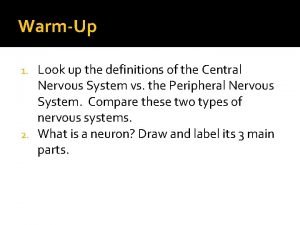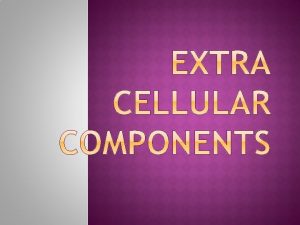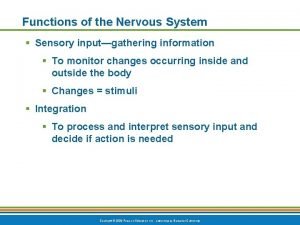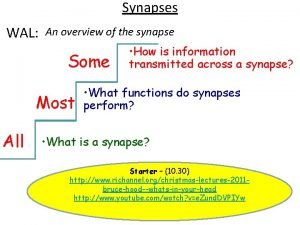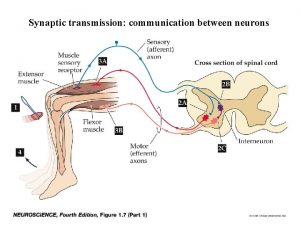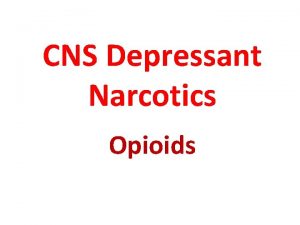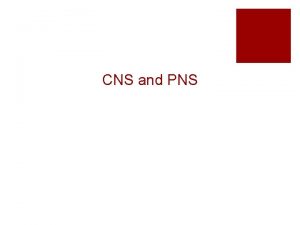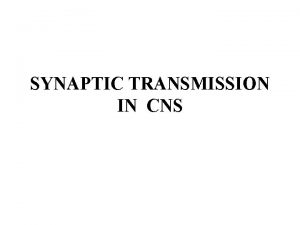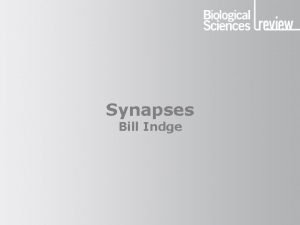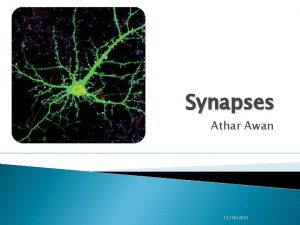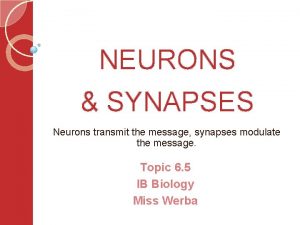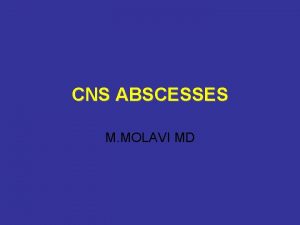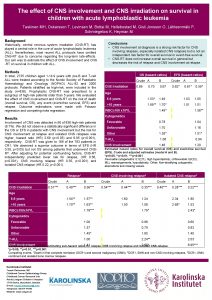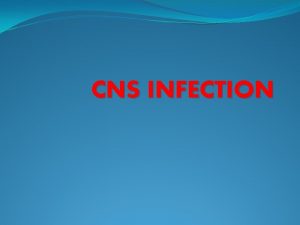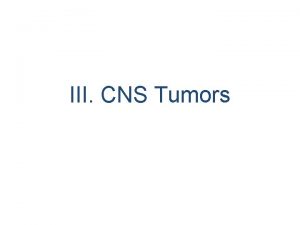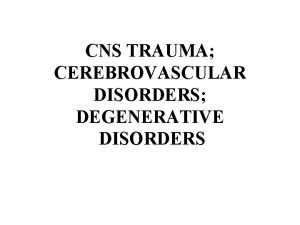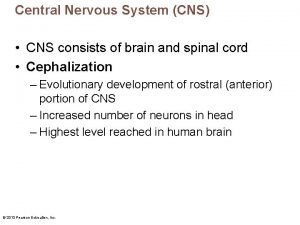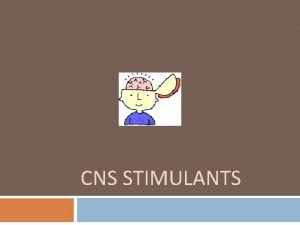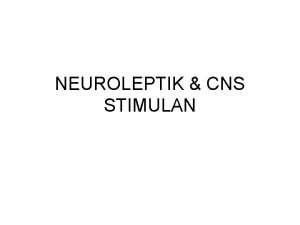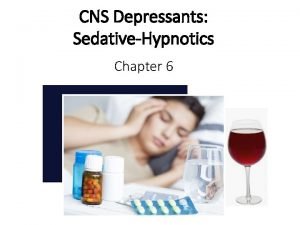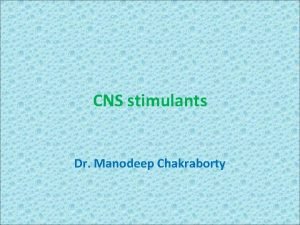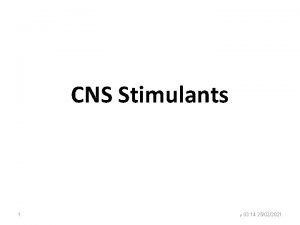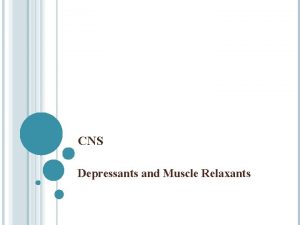SYNAPSES PROCESSING OF SINGALS THE CNS The synapses






































- Slides: 38

SYNAPSES &PROCESSING OF SINGALS THE CNS The synapses are the junctions between neurons. The neuron that conducts nerve impulses towards the synapse is called presynaptoc neuron, while that carrying impulses away from the synapse is called postsynaptic neuron. Near the synapse , the presynaptic neuron divides into many branches, each of which ends by a button-like swelling known as the synaptic knob.

SYNAPSES &PROCESSING OF SINGALS THE CNS n n The axon of the presynaptic neuron may terminate on the dendrites, soma or axon of the postsynaptic neuron. Thus, histologically, synapse are divided into (a)axo-dendritic (b)axo-somatic (c)axo-axonic.

SYNAPSES &PROCESSING OF SINGALS THE CNS n Each presynaptic axon divides into about 1000 branches on the average, each of which ends by a knob(synaptic knobs). Large numbers of such knobs (derived from multiple presynaptic neurons)terminate on postsynaptic neurons(g. g. 10000 -100000 knobs terminate on each spinal motor neuron)and at the site of contact, the knobs are separated from the postsynaptic membranes by gaps 30 -50 nm wide and filled with ECF, called synaptic clefts.

SYNAPTIC TRANSMISSION n n During rest , both the synaptic knobs and postsynaptic neurons are in the polarized state(having a RMP about -70 m V ). When the presynaptic neuron is stimulated , an AP is transmitted along its axon towards the synaptic knobs, where it causes reversal of polarity. Such change increases the permeability of the synaptic knob membrane to Ca++(by opening voltage-gated Ca++channels)which will thus diffuse into the knobs. Ca++ cause fusion of the vesicles to the synaptic knob membranes, and the area of fusion then breaks down resulting in liberation of the neurotransmitter into the synaptic cleft (by a process of exocytosis).

SYNAPTIC TRANSMISSION n The transmitter diffuses across the synaptic cleft and combines with specific receptors at the membrane of the postsynaptic neuron. This leads to opening of channels or gates in the postsynaptic membrane, allowing passage of various ions(Na+, K+, &Cl-), which cause certain electrophysiological changes(the nature of which depends on the released transmitter), resulting in either excitation or inhibition of the postsynaptic neuron

NATURE OF POSTSYNAPTIC CHANGE n n The presynaptic neuron releases a neurotransmitter which leads to either: 1 -Excitation of postsynaptic neuron: The synapses at these sites are called excitatory synapses, and the common excitatory transmitters include acetycholine, noradrinaline, and serotonin.

NATURE OF POSTSYNAPTIC CHANGE n 2 -Inhibition of postsynaptic neuron: The synapses at these sites are called inhibitory synapses, and the common inhibitory transmitters include gammaaminobutyric acid (GABA)and the amino acid glycine.

SYNAPTIC TRANSMITTERS n n n The following are some of the identified synaptic transmitter agents and their locations: 1 -Amino acids e. g. glutamate in cerebral cortex and brain stem and aspartate in the spinal cord. 2 -Substance P in endings of pain conducting afferent nerves, and many parts of the brain. 3 -Enkephalins in the spinal cord, and pain analgesia system. 4 -B-endorphin in thalamus and brain stem.

SYNAPTIC TRANSMITTERS n n 5 -Gastrointestinal hormones e. g. CCK, VIP & secretin in cerebral cortex &hypothalamus the later also in thalamus, brain stem. Gastrin in hypothalamus and medulla oblongata, and motilin in cerebral cortex and cerebellum. 6 -Angiotensin II in hypothalamus, amygdaloid nucleus brain stem and spinal cord. 7 -Atrial &brain natriuretic peptides in hypothalamus and brain stem. 8 -Histamine in the hypothalamus limbic system, &other parts of the cerebral cortex.

SYNAPTIC RECEPTORS n n There are 2 types of synaptic receptors: 1 -Presynaptic receptors: These are present at many synaptic junctions, and they often inhibit further secretion of the transmitter(providing a feedback control mechanism for its release)e. g. at noradrenergic synapses there alpha 2 presynaptic receptors which, when stimulated by the released norepinephrine, inhibit further release of this transmitter.

SYNAPTIC RECEPTORS n n n 2 -Postsynaptic receptors: For each neurotransmitter, there are usually many subtypes of postsynaptic receptors e. g. -The muscarinic &nicotinic receptors of acetycholine. -Alpha 1&2 and beta 1&2 adrenergeic receptors.

SYNAPTIC RECEPTORS n n n -Opiate receptors: There are different receptors for enkephalins, endorphins &dynorphins. -Dopamine D receptors: There are definitely 2 dopamine receptors (D 1&D 2 receptors), and possibly also a third (D 3) receptor. -Serotonin receptors: 6 different tupes of serotonin receptors have been identified , at least some of which are presynaptic.

SYNAPTIC RECEPTORS n -Histamine (H) receptors: There are 3 types of histamine receptors (H 1, H 2&H 3). Most H 3 receptors are presynaptic (mediating inhibition of histamine secretion

REMARKS ON SOME NEUROTRANSMITTERS n n ACETYLCHOLINE: -Ac. ch. is formed as a result of combination of choline and active acetate by the effect of choline-acetyltransferase enzyme, and various members of vitamin B complex are important for its synthesis. It is destroyed by the cholinesterase, enzyme.

REMARKS ON SOME NEUROTRANSMITTERS n n ACETYLCHOLINE: -It exerts its effects through acting on 2 types of receptors, the muscarinic & nicotinic receptors. The nicotinic receptors are present in the autonomic ganglia &motor end plates. On the other hand, there are 2 types of muscaric receptors. M 1, M 2. M 1 receptors are found in the C. N. S &elsewhere , while M 2 receptors are found mainly in the heart(& at some other locations)

REMARKS ON SOME NEUROTRANSMITTERS n n n ACETYLCHOLINE: -It is an excitatory transmitter. It produces an excitatory postsynaptic potential(EPSP)by closing K+ channels(thus decreasing K+ conductance), and also to a lesser extent by increasing the permeability of postsynaptic membranes to. Na+) -It is essential for motor functions of the cortex, as well as for higher intellectual cortical functions(aruousal state, attention, memory and learning). In large doses, it may lead to convulsions

REMARKS ON SOME NEUROTRANSMITTERS n n ACETYLCHOLINE: -In the basal ganglia, Ac. ch. is an excitatory transmitter while dopamine is an inhibitory transmitter, and normally there is a cholinergic-dopaminergic balance.

REMARKS ON SOME NEUROTRANSMITTERS n n DOPAMINE Is one of the catecholamines(which are synthesized from the amino acids phenyalanine and tyrosine). In the CNS, it is present in the basal ganglia, hypothalamus &some areas in the limbic system. It is mostly an excitatory transmitter, but in the basal ganglia it is inhibitory.

REMARKS ON SOME NEUROTRANSMITTERS n n DOPAMINE In Parkinson’s disease the normal balance between dopamine and Ac. ch. in the basal ganglia is disturbed. Both dopamine &dopamine receptors are decreased, while A. ch is increased. The symptoms of this disease can be therefore improved by drugs that increase the dopamine content in the basal ganglia specially L-dopa, and also by anticholinergic drugs(e. g. momatropine)

REMARKS ON SOME NEUROTRANSMITTERS n n n DOPAMINE In the famous disease known as schizophrenia, the dopamine level in the brain is increased. The phenothiazine group of tranquilizers block certain dopamine receptors(D 2)that are useful in the treatment of this disease. Dopamine is also the prolactine-inhibiting hormone, so L-dopa is also useful in the treatment of gynaecomastia.

REMARKS ON SOME NEUROTRANSMITTERS n n SEROTONIN This is synthesized from the amino acid tryptophan in the enterochromaffin cells in the GIT, and is stored in the blood platelets. In the CNS serotonin –containing neurons are present mainly in the raphe nuclei of the brain stem , and they project to the hypothalamus , limbic system &spinal cord.

REMARKS ON SOME NEUROTRANSMITTERS n n n n SEROTONIN Exerts the following functions: 1 -It is inhibitory for pain sensation: There is a descending sysem of neurons from the raphe nuclei to the dorsal horns of the spinal cord which inhibits pain sensation. 2 -It may play a role in sleep 3 -It may play an excitatory role in the regulation of prolactin secretion. 4 -It may be involved in the regulation of circadian rhythmus. 5 -It is sad to inhibit sexual excitation.

REMARKS ON SOME NEUROTRANSMITTERS n n GAMMA-AMINOBUTYRIC ACID (GABA) GABA is an inhibitory neurotransmitter in the brain and is the mediator responsible for presynaptic inhibition. There are 2 GABA receptors, A&B. The A receptors act by increasing Clconductance, while the B receptors act by increasing K+ conductance.

REMARKS ON SOME NEUROTRANSMITTERS n n GABA is formed by decarbxylation of glutamate. Vitamin B 6 is an important cofactor in its synthesis, thus if it is deficient, GABA formation is reduced leading to neuronal hyperexcitability &convulsions. The action of GABA is facilitated by diazepam and barbiturates, potentiated by alcohol and antagonized by picrotoxin.

REMARKS ON SOME NEUROTRANSMITTERS n n GLYCINE Is an inhibitory transmitter in the spinal cord, and is responsible for postsynaptic inhibition. The glycine receptor acts mainly by increasing Cl- conductance producing a state of hyperpolarization at the postsynaptic neurons called inhibitory postsynaptic potential(IPSP)

REMARKS ON SOME NEUROTRANSMITTERS n n GLUTAMATE&ASPARTATE Glutamate is widely used as an excitatory transmitter in the brain and it has been calculated that it is the transmitter responsible for 75% of the excitatory transmission, in the brain. There are 3 types of glutamate receptors and aspartate binds to 2 of them. When such receptors are activated they permit Na+ influx. .

EXCITATORY SYNAPSES n n n The following phenomena occur at the excitatory synaptic junctions: 1 -Miniature excitatory postsynaptic potential: (m. EPSP) During rest, some Ca++ ions diffuse into the synaptic knobs along a concentration gradient leading to rupture of few vesicles.

EXCITATORY SYNAPSES n The released excitatory transmitter combines with few receptors in the postsynaptic membrane leading to an increase in Na+conductance through opening of voltagegated Na+channels. This results in Na+ influx leading to a state of minute depolarization at the postsynaptic membrane, which is called (m. EPSP). This indicates that during rest the excitatory synapses are partially active.

EXCITATORY SYNAPSES n n 2 -Excitatory postsynaptic potential(EPSP) Stimulation of an excitatory presynaptic neuron leads to reversal of polarity at its terminal knobs, which markedly increases their permeability to Ca++, leading to rupture of a large number of vesicles &liberation of their transmitter, which diffuses across the synaptic cleft and combine with the receptors at the postsynaptic membrane.

EXCITATORY SYNAPSES n This increases Na+ conductance through opening of voltage-gated Na+ thus Na+ ions flow inside the postsynaptic neuron, favoured by concentration &electric gradients. Such Na+ influx leads to depolarization of the postsynaptic membrane, which is called EPSP which is localized &lasts for 15 ms.

Summation of EPSPs: n The EPSP due to activity in a single synaptic knob is so small , thus it cannot generate an AP in the postsynaptic neuron. The EPSP is not an all or none response, and the depolarization produced by multiple EPSPs can summate into a greater depolarizing potential which , if large enough to reach the firing level, can initiate an AP.

Summation of EPSPs: n Therefore, summation of EPSPs is essential to produce a propagated AP along the postsynaptic neuron. Such summation is of 2 types:

Summation of EPSPs: n n 1 -Spatial summation: It occurs by stimulation of several presynaptic fibers simultaneously, which results in activation of more than one synaptic knob at the same time 2 -Temporal summation: This occurs by stimulation of single presynaptic fiber repetitively. The successive EPSPs summate provided the intervals between them do not exceed 15 ms, thus increasing the depolarization of the postsynaptic membrane to the threshold of firing , resulting in production of a propagated AP along the post synaptic neuron.

INHIBITORY SYNAPSES n At inhibitory synaptic junctions, postsynaptic inhibition occurs by several ways. The various types of synaptic inhibition &their mechanisms include the following:

INHIBITORY SYNAPSES n n n 1 -Postsynaptic inhibition(IPSP) In this type, the terminal knobs of the inhibitory presynaptic neuron are in contact with the postsynaptic neuron. Stimulation of this presynaptic neuron causes reversal of polarity at its terminal knobs and this increases their permeability to Ca++ which diffuse into these synaptic knobs, leading to rupture of vesicles & liberation of the inhibitory transmitter (which is the amino acid glycine)into the synaptic cleft.

INHIBITORY SYNAPSES n Glycine combines with the receptors in the postsynaptic membrane resulting in opening of Cl- channels, thus Clconductance is markedly increased.

INHIBITORY SYNAPSES n Localized opening of K+ channels also occurs leading to movement of K+ out of the postsynaptic neuron. These ionic changes lead to hyper polarization at the postsynaptic neuron, during which the excitability of the neuron to other stimuli is decreased, so it is called inhibitory postsynaptic potential(IPSP). It is to be noted that IPSPs can also be produced by closure of Na+ or Ca++ channels.

INHIBITORY SYNAPSES n n 2 -Presynaptic inhibition: In this type, the inhibitory neuron ends on a excitatory synaptic knob, and not directly on the postsynaptic neuron. The inhibitory transmitter in this case is GABA. 3 -Negative feedback inhibition: Neurons at various levels of the CNS may also inhibit themselves by negative feed back mechanism. A nerve fiber gives a collateral branch which excites an inhibitory interneuron, and this in turn, inhibits the original neuron as well as the surrounding neurons(e. g. Renshaw cells)
 Cns international school
Cns international school Cns ischemic response
Cns ischemic response Vermis sheep brain
Vermis sheep brain Proprioception
Proprioception Pagitane
Pagitane Cns depressants ppt
Cns depressants ppt Depresori cns
Depresori cns Cns
Cns Nervous system histology ppt
Nervous system histology ppt Grading of reflexes
Grading of reflexes Cns poruchy
Cns poruchy Classification of cholinergic drugs
Classification of cholinergic drugs Bainbridge reflex
Bainbridge reflex Cns ward
Cns ward Ltpd表
Ltpd表 Cns15506
Cns15506 Cns
Cns Composition of cns
Composition of cns Classification of cns
Classification of cns Dermatomes
Dermatomes Cns educar
Cns educar Www.lispa.it cns
Www.lispa.it cns Cnscp
Cnscp Cns
Cns Naas cns
Naas cns Depresori cns
Depresori cns Cns ischemic response
Cns ischemic response Soma cns
Soma cns Neutron capture
Neutron capture Soma cns
Soma cns Ans and cns difference
Ans and cns difference Reeling gait
Reeling gait Image of central nervous system
Image of central nervous system Haemorrhage
Haemorrhage Bioflix activity: how synapses work -- synapse structure
Bioflix activity: how synapses work -- synapse structure Plasmodesmata
Plasmodesmata How is one way conduction at synapses ensured
How is one way conduction at synapses ensured Functions of the synapse
Functions of the synapse Chemical synapses
Chemical synapses

